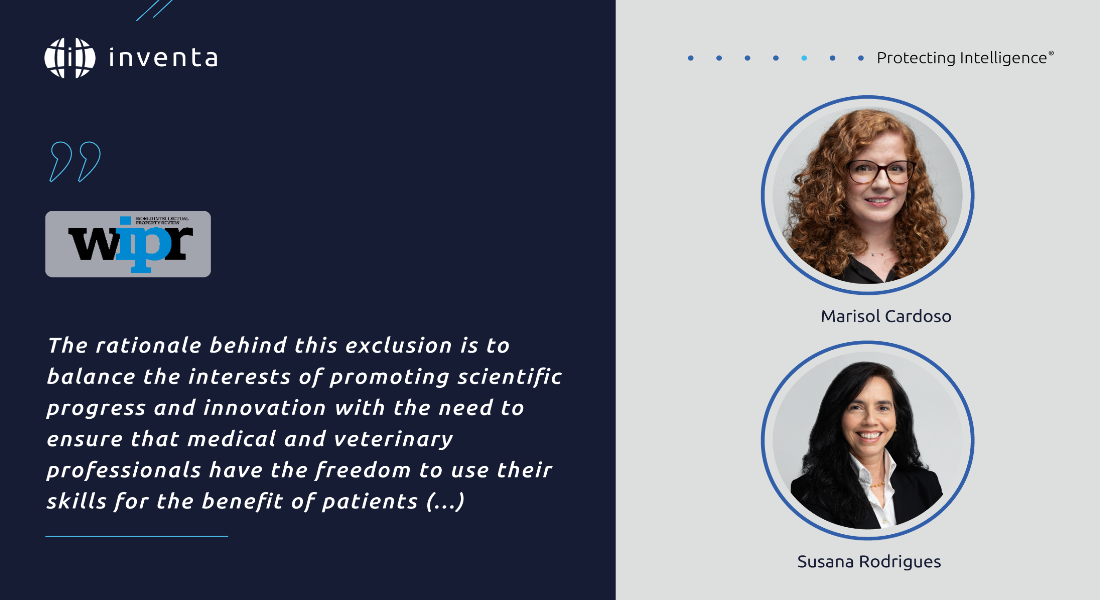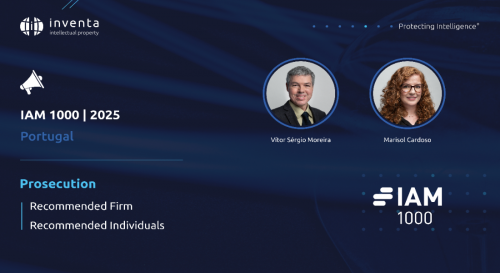
Exclusions to healthcare treatment methods under the EPC
It is well known that patents can be granted for inventions (products, processes or methods and practical applications or uses) that are novel, inventive, and provided with industrial applicability.
However, in Europe, as in many other jurisdictions, certain types of inventions are not considered patentable. To this end, the European Patent Convention (EPC) sets forth the patentability criteria and Article 53 outlines its exceptions, that include:
(a) inventions which commercial exploitation would be contrary to ‘ordre public’ or morality;
(b) plant or animal varieties or essentially biological processes for the production of plants or animals; and
(c) methods for treatment of the human or animal body by surgery or therapy and diagnostic methods practised on the human or animal body.
In this article, it is our objective to better understand the exceptions under Article 53(c) EPC by analysing Decisions of a Technical Board of Appeal (T decisions).
It is also our objective to determine possible ways to avoid an exclusion objection when drafting a patent application or to overcome an unfavourable decision during patent prosecution.
Breaking down Article 53(c) EPC
The exclusion of methods of treatment from patentability is a principle based on socio-ethical and public health considerations.
The rationale behind this exclusion is to balance the interests of promoting scientific progress and innovation with the need to ensure that medical and veterinary professionals have the freedom to use their skills for the benefit of patients without being hindered by exclusive patent rights.
The medical profession is often guided by ethical principles that prioritise patient welfare and the physician’s duty to provide the best available care.
When it comes to public policy, the interest in excluding methods of treatment from patentability aims to ensure that medical practitioners can freely use and share knowledge about effective methods of treatment without interfering with their availability, as well as allowing healthcare to remain accessible to a broader population.
It is important to emphasise that patents can still be granted for medical products and processes involved in their production. This allows for the protection of tangible inventions that contribute to medical advancements while maintaining a balance between innovation and the broader public interest in health and access to medical care.
The dos and don’ts: implementing EPC rules and guidelines
The EPC rules the actions of the European Patent Office (EPO) and establishes a uniform patenting system for all countries signatory to the Convention. However, the EPC itself does not have detailed procedural and substantive rules for the application and examination process.
Due to this fact, the EPC Implementing Regulations determine in more detail how the EPC Articles should be applied, and the EPC Guidelines give instructions on the practice and procedure to be followed in the various aspects of the examination of European applications and patents.
In this sense, exceptions under Article 53(c) are limited to methods for treatment of the human or animal body by surgery (non-invasive or invasive procedures) or therapy (curing and prophylactic) and / or diagnostic methods practised on the human or animal body.
In other words, to be excluded from patentability, a treatment or diagnostic method must actually be carried out on the living body (and no distinction is to be made between human beings and animals).
As regards diagnostic methods, it must be ascertained whether an interaction with the human or animal body takes place in order to determine if the method step fulfils the criterion “practised on the human or animal body”. Usually, this criterion is fulfilled if the performance of the method step in question necessitates the presence of the body (direct physical contact with the body is not required).
It is also important to have in mind that a method claim is not allowable under Article 53(c) EPC if it includes at least one feature defining a physical activity or action that constitutes a method step for treatment of the human or animal body by surgery or therapy.
To be allowed, the non-patentable subject-matter must be removed from the scope of the claim, which can be done by means of a disclaimer or by omitting the step of treatment from the wording of the claim.
Analysing T decisions
Case 1: Carefusion (T3124/19)
Carefusion, a company from San Diego, California, filed a European patent application referring to a method directed to associating objects within a certain physical space and a system implementing the method.
Various medicines prescribed by a doctor to treat a patient, the patient and a caregiver are such objects. More specifically, the method and the system of the invention assign a specific medicine at a specific time and dose to the patient, wherein the medicine is handed by the caregiver to the patient.
The patent application was refused by the examining division at the EPO: the examiners not only alleged lack of inventive step, but they had considered that the patent application would fall in the exclusions to patentability—under Article 53(c)—as a method of treatment to a patient. Carefusion then filed an appeal related to such a decision.
The appeal procedure ended in a clear opinion concerning whether the invention was falling within Article 53(c). The Board of Appeal of the EPO was of the opinion that the medication selection included in the method of the invention wasn’t taking into account the illness of the patient but instead the prescription of the doctor, previously done and not included in the method steps.
The step of selecting a medication only concerns keeping a human handling free from errors, thus having no connection to the therapeutic effect on the patient.
Earlier this month, on March 11, an intention to grant this patent was communicated to Carefusion.
Case 2: Brainlab (T1256/17)
Another example of the interpretation of Article 53(c) that gave rise to a case law originated in a European patent application filed by German company Brainlab.
The invention seeking patent protection refers to a method for operating a medical navigation system comprising a stationary marker and an electronic device attached to a bone. A video camera assisting in the calculation of a mechanical axis of that bone is also included, wherein such calculation is based on the bone rotation and its change in position relative to the marker position. The invention also refers to the system operated according to the method.
The patent application has been refused by the examining division, based on Article 53(c), on the grounds that, in order to attach an electronic device to a bone, a surgery is needed, which is a treatment method excluded from patentability.
The applicant appealed the decision of refusal, with the argument that the method of the invention involved bone pivoting steps, which aren’t surgical per se, since the method steps do not include the attachment of the electronic device to the bone. This step would be done before the method claimed, Brainlab argued.
The Board of Appeal assigned to the job agreed with the examining division in that the determination of the mechanical axis of the bone can only be carried out with an electronic device attached to it, which cannot be considered without a surgery operation being present.
Thus, the Board decision was to consider the method claimed as falling within Article 53(c) and the method claims have been deleted from the patent application. The Board then remitted the case to the examining division for resuming the examination processing, and the decision of refusal under appeal was thus set aside.
The patent was eventually granted for the system only.
Conclusions
It should be considered that the intention of Article 53(c) EPC is to allow medical and veterinary practitioners to use their skills and knowledge of the best available treatments to achieve the utmost benefit for their patients without being constrained by patent rights.
Granting patents on treatment methods could create barriers to accessing healthcare and excluding such subject matter from patentability has the sole objective of safeguarding patient needs.
This is a co-published article, which was originally published in the World Intellectual Property Review (WIPR).
Currency Info
Final charges will be made in USD.
Currency conversion is for information purposes only and accuracy is not guaranteed. Overseas customers are encouraged to contact their bank or credit card provider for details on any additional fees these institutions may include for currency conversion.
- USD 312.389 NGN
Territory List
There are no results for your search.
- Africa
- Algeria
- Angola
- Benin
- Botswana
- Burkina Faso
- Burundi
- Cameroon
- Cape Verde
- Central African Republic
- Chad
- Comoros
- Congo (Republic)
- Côte d'Ivoire
- Democratic Republic of the Congo
- Djibouti
- Egypt
- Equatorial Guinea
- Eritrea
- Eswatini (Swaziland)
- Ethiopia
- Gabon
- Gambia
- Ghana
- Guinea
- Guinea-Bissau
- Kenya
- Lesotho
- Liberia
- Libya
- Madagascar
- Malawi
- Mali
- Mauritania
- Mauritius
- Mayotte
- Morocco
- Mozambique
- Namibia
- Niger
- Nigeria
- Réunion
- Rwanda
- Sao Tome and Principe
- Senegal
- Seychelles
- Sierra Leone
- Somalia
- South Africa
- South Sudan
- Sudan
- Tanzania (mainland)
- Togo
- Tunisia
- Uganda
- Western Sahara
- Zambia
- Zanzibar
- Zimbabwe
- Africa (OAPI)
- Africa (ARIPO)
- Other
- East Timor
- Macao
- Maldives
- Portugal
- European Patent (EPO)
- European Union Trademark (EUTM)
- International Trademark (Madrid System)
- Patent Cooperation Treaty (PCT)




